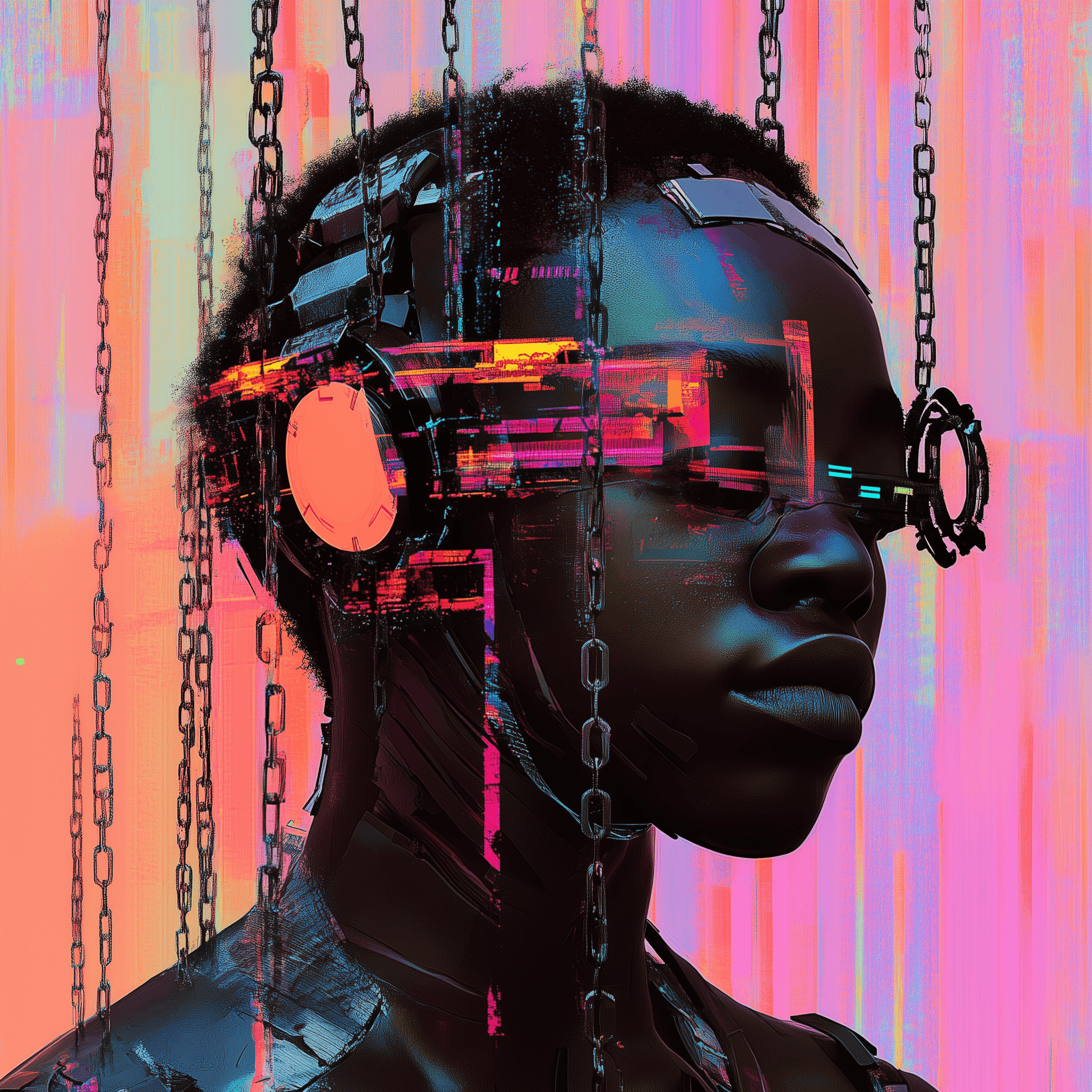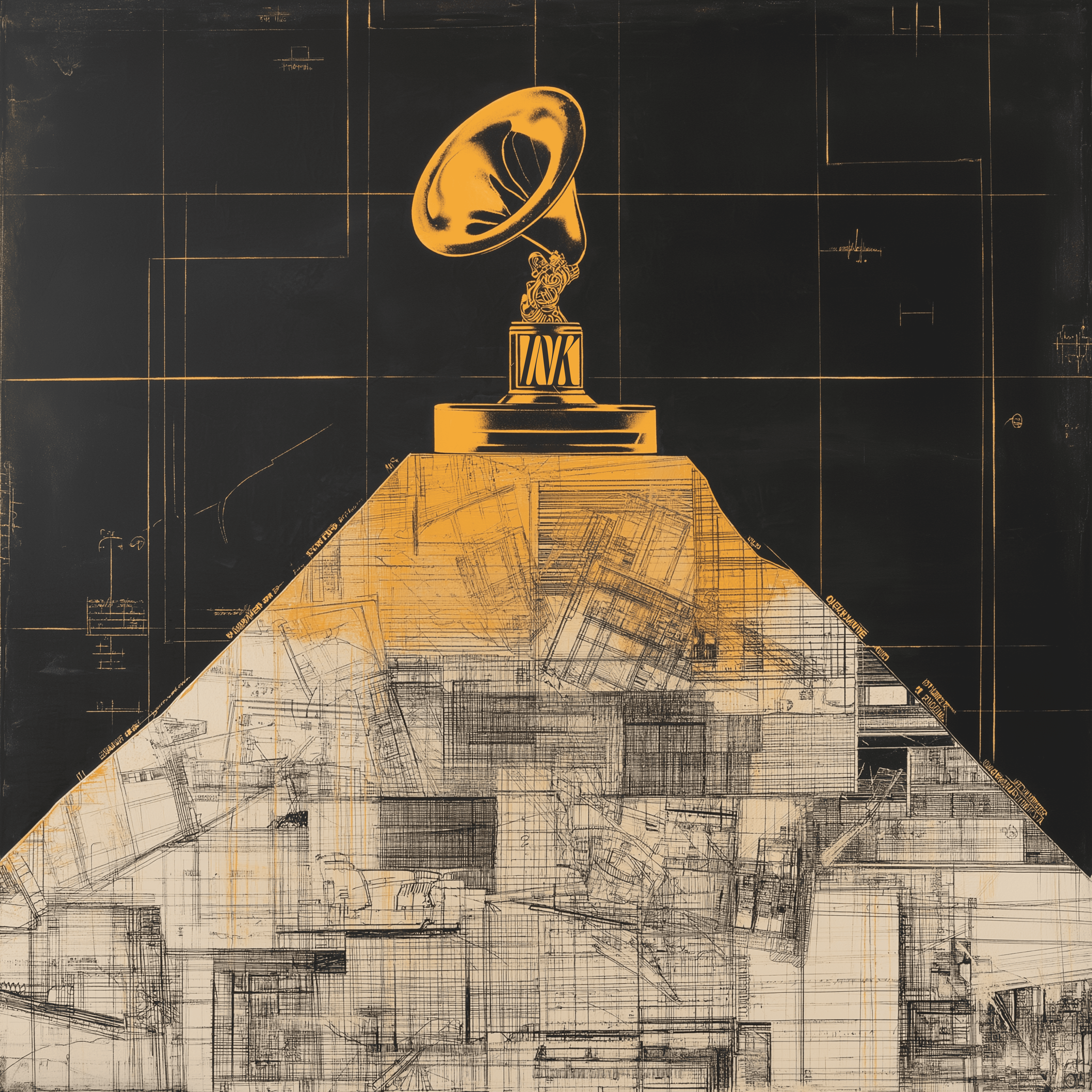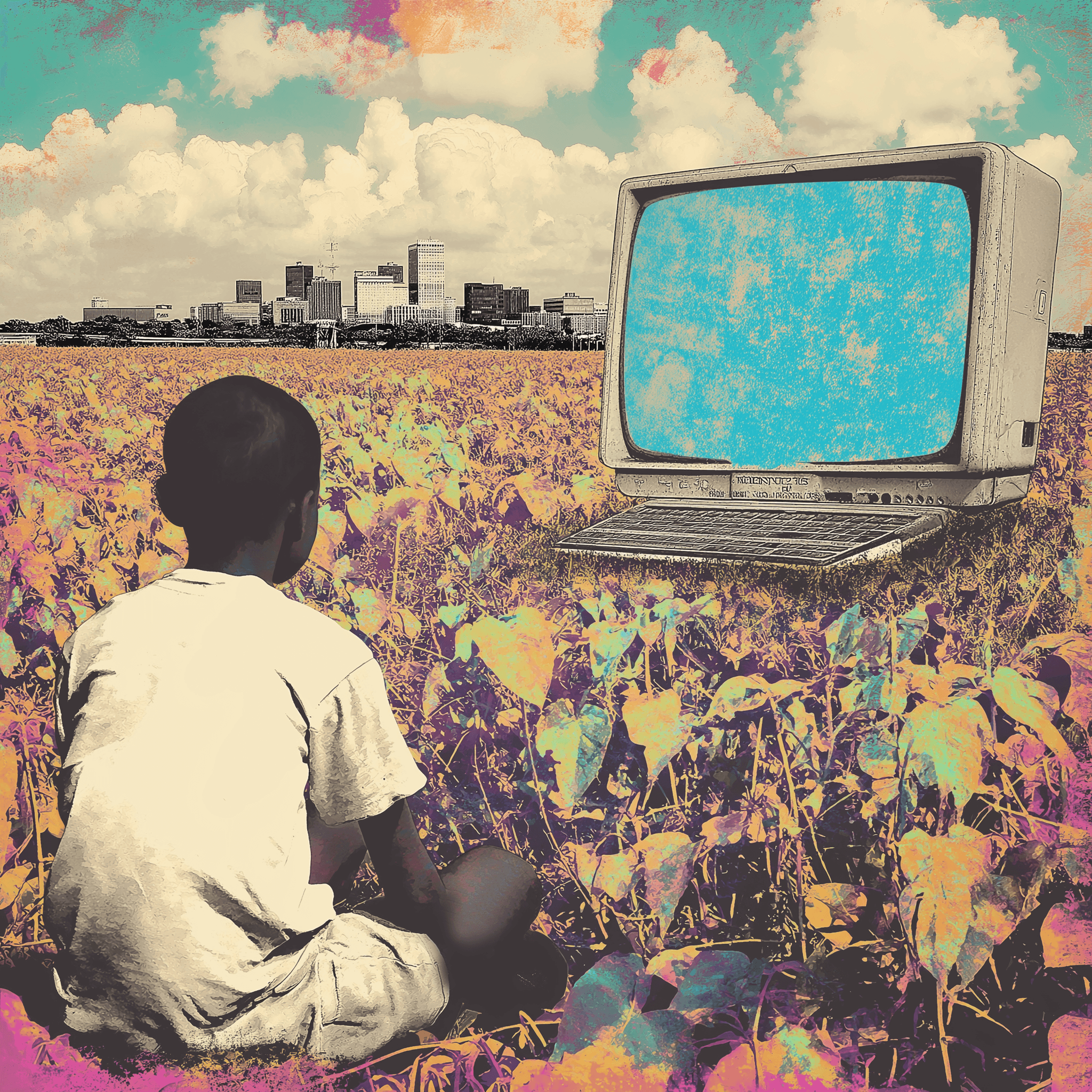Oct 1, 2024
Own Your Masters, and the Algorithms
Own Your Masters, and the Algorithms
A thoughtful reflection on how technology is reshaping the boundaries of creativity, performance, and ownership
A thoughtful reflection on how technology is reshaping the boundaries of creativity, performance, and ownership



The cadre of disco, blues, gospel, and rock in the 1960s and early 70s flourished on the back of electric music instruments and multi-track recording technology. Artists like Sly & the Family Stone, The Jackson 5, George Clinton, and Sun Ra evolved from the limitations of early analog tape machines to the possibilities offered by the Moog synthesizer, 16-track systems, and reverb.
I’ve recently relished in the antiquity of that era, smiling whenever I catch wind of grainy vocals and vinyl static. To be a superstar at that time felt magical—elusive. And, while that magic hasn’t disappeared, technology has changed the landscape, opening the floodgates for nearly anyone to become a recording artist. So much, in fact, that I’ve found myself lost in the catacombs of SoundCloud, YouTube, and Spotify—jamming out to anti-pop iconoclasts and imitations of my pop-tune favorites. At the end of my three-hour listening stints, I realize there’s enough great music to enjoy over ten lifetimes. That’s a win for listeners but a daunting hurdle for artists.
Already, anyone can mimic live instrumentation on their iPad and access recording software with a mouse click on Amazon. And, since the musical wizardry isn’t solely in the production, songwriting, or vocal performance anymore, it’s understandable why artists invest heavily in live performances, social media, and other spaces, like theater and television.
Of course, it doesn’t stop there. AI has now been woven into the fabric of the music industry, fundamentally reshaping how we create and experience sound. Drake’s diss track against Kendrick Lamar, featuring the AI-generated voices of Tupac and Snoop Dogg, exposed this profound and unsettling shift. He didn’t just mimic their voices; he weaponized them, turning these West Coast hip-hop icons into tools of poetic warfare. I thought it was brilliant—but the lines between human creativity and algorithmic manipulation have grown blurry.
I’m unconvinced that AI is our proverbial nuclear fission; maybe it’s our chance to generate a new kind of energy around music, reshaping the business and the culture that keeps it. With virtual concerts in Fortnite and AI-generated remixes on TikTok, the future of music is no longer confined to sound alone. Success now demands that artists build immersive experiences for their audiences. But what if we took it a step further?
What if artists embraced—not just adapted to—the very infrastructure that supports and monetizes these experiences? After all, past innovators didn’t merely react to new technology; they built upon it to define entire genres and business opportunities.
Let’s consider a future where artists leverage predictive models and AI to streamline the operational side of their careers. Imagine a platform that analyzes data from past bookings, social media interactions, and venue sizes to optimize tour planning. With AI-driven forecasting, artists could dynamically adjust their tour schedules or add venues in real time, based on shifting demand and local economic trends.
Or envision an AI-powered feedback loop, where artists test early versions of tracks with targeted beta audiences, gathering real-time, data-driven insights. This platform could analyze skips, replays, and drop-offs, offering invaluable feedback during the creative process before a major release. Such tools would offer artists far more than just a peek behind the curtain—they would provide actionable insights that drive artistic decisions.
These ideas aren’t mere speculation. They represent a blueprint for the future of artistry and entrepreneurship. Platforms like Audius, which uses blockchain to reward artists more fairly, are already hinting at these future paradigms.
In this evolving landscape, musicians are more than just artists—they are entrepreneurs, beta testers of innovation, and technologists shaping the cultural zeitgeist.
The future of music transcends the notes an artist will play or the lyrics they’ll pen. It lies within the platforms they’ll engage with, the innovations they’ll embrace, and the data they’ll harness.
The cadre of disco, blues, gospel, and rock in the 1960s and early 70s flourished on the back of electric music instruments and multi-track recording technology. Artists like Sly & the Family Stone, The Jackson 5, George Clinton, and Sun Ra evolved from the limitations of early analog tape machines to the possibilities offered by the Moog synthesizer, 16-track systems, and reverb.
I’ve recently relished in the antiquity of that era, smiling whenever I catch wind of grainy vocals and vinyl static. To be a superstar at that time felt magical—elusive. And, while that magic hasn’t disappeared, technology has changed the landscape, opening the floodgates for nearly anyone to become a recording artist. So much, in fact, that I’ve found myself lost in the catacombs of SoundCloud, YouTube, and Spotify—jamming out to anti-pop iconoclasts and imitations of my pop-tune favorites. At the end of my three-hour listening stints, I realize there’s enough great music to enjoy over ten lifetimes. That’s a win for listeners but a daunting hurdle for artists.
Already, anyone can mimic live instrumentation on their iPad and access recording software with a mouse click on Amazon. And, since the musical wizardry isn’t solely in the production, songwriting, or vocal performance anymore, it’s understandable why artists invest heavily in live performances, social media, and other spaces, like theater and television.
Of course, it doesn’t stop there. AI has now been woven into the fabric of the music industry, fundamentally reshaping how we create and experience sound. Drake’s diss track against Kendrick Lamar, featuring the AI-generated voices of Tupac and Snoop Dogg, exposed this profound and unsettling shift. He didn’t just mimic their voices; he weaponized them, turning these West Coast hip-hop icons into tools of poetic warfare. I thought it was brilliant—but the lines between human creativity and algorithmic manipulation have grown blurry.
I’m unconvinced that AI is our proverbial nuclear fission; maybe it’s our chance to generate a new kind of energy around music, reshaping the business and the culture that keeps it. With virtual concerts in Fortnite and AI-generated remixes on TikTok, the future of music is no longer confined to sound alone. Success now demands that artists build immersive experiences for their audiences. But what if we took it a step further?
What if artists embraced—not just adapted to—the very infrastructure that supports and monetizes these experiences? After all, past innovators didn’t merely react to new technology; they built upon it to define entire genres and business opportunities.
Let’s consider a future where artists leverage predictive models and AI to streamline the operational side of their careers. Imagine a platform that analyzes data from past bookings, social media interactions, and venue sizes to optimize tour planning. With AI-driven forecasting, artists could dynamically adjust their tour schedules or add venues in real time, based on shifting demand and local economic trends.
Or envision an AI-powered feedback loop, where artists test early versions of tracks with targeted beta audiences, gathering real-time, data-driven insights. This platform could analyze skips, replays, and drop-offs, offering invaluable feedback during the creative process before a major release. Such tools would offer artists far more than just a peek behind the curtain—they would provide actionable insights that drive artistic decisions.
These ideas aren’t mere speculation. They represent a blueprint for the future of artistry and entrepreneurship. Platforms like Audius, which uses blockchain to reward artists more fairly, are already hinting at these future paradigms.
In this evolving landscape, musicians are more than just artists—they are entrepreneurs, beta testers of innovation, and technologists shaping the cultural zeitgeist.
The future of music transcends the notes an artist will play or the lyrics they’ll pen. It lies within the platforms they’ll engage with, the innovations they’ll embrace, and the data they’ll harness.
The cadre of disco, blues, gospel, and rock in the 1960s and early 70s flourished on the back of electric music instruments and multi-track recording technology. Artists like Sly & the Family Stone, The Jackson 5, George Clinton, and Sun Ra evolved from the limitations of early analog tape machines to the possibilities offered by the Moog synthesizer, 16-track systems, and reverb.
I’ve recently relished in the antiquity of that era, smiling whenever I catch wind of grainy vocals and vinyl static. To be a superstar at that time felt magical—elusive. And, while that magic hasn’t disappeared, technology has changed the landscape, opening the floodgates for nearly anyone to become a recording artist. So much, in fact, that I’ve found myself lost in the catacombs of SoundCloud, YouTube, and Spotify—jamming out to anti-pop iconoclasts and imitations of my pop-tune favorites. At the end of my three-hour listening stints, I realize there’s enough great music to enjoy over ten lifetimes. That’s a win for listeners but a daunting hurdle for artists.
Already, anyone can mimic live instrumentation on their iPad and access recording software with a mouse click on Amazon. And, since the musical wizardry isn’t solely in the production, songwriting, or vocal performance anymore, it’s understandable why artists invest heavily in live performances, social media, and other spaces, like theater and television.
Of course, it doesn’t stop there. AI has now been woven into the fabric of the music industry, fundamentally reshaping how we create and experience sound. Drake’s diss track against Kendrick Lamar, featuring the AI-generated voices of Tupac and Snoop Dogg, exposed this profound and unsettling shift. He didn’t just mimic their voices; he weaponized them, turning these West Coast hip-hop icons into tools of poetic warfare. I thought it was brilliant—but the lines between human creativity and algorithmic manipulation have grown blurry.
I’m unconvinced that AI is our proverbial nuclear fission; maybe it’s our chance to generate a new kind of energy around music, reshaping the business and the culture that keeps it. With virtual concerts in Fortnite and AI-generated remixes on TikTok, the future of music is no longer confined to sound alone. Success now demands that artists build immersive experiences for their audiences. But what if we took it a step further?
What if artists embraced—not just adapted to—the very infrastructure that supports and monetizes these experiences? After all, past innovators didn’t merely react to new technology; they built upon it to define entire genres and business opportunities.
Let’s consider a future where artists leverage predictive models and AI to streamline the operational side of their careers. Imagine a platform that analyzes data from past bookings, social media interactions, and venue sizes to optimize tour planning. With AI-driven forecasting, artists could dynamically adjust their tour schedules or add venues in real time, based on shifting demand and local economic trends.
Or envision an AI-powered feedback loop, where artists test early versions of tracks with targeted beta audiences, gathering real-time, data-driven insights. This platform could analyze skips, replays, and drop-offs, offering invaluable feedback during the creative process before a major release. Such tools would offer artists far more than just a peek behind the curtain—they would provide actionable insights that drive artistic decisions.
These ideas aren’t mere speculation. They represent a blueprint for the future of artistry and entrepreneurship. Platforms like Audius, which uses blockchain to reward artists more fairly, are already hinting at these future paradigms.
In this evolving landscape, musicians are more than just artists—they are entrepreneurs, beta testers of innovation, and technologists shaping the cultural zeitgeist.
The future of music transcends the notes an artist will play or the lyrics they’ll pen. It lies within the platforms they’ll engage with, the innovations they’ll embrace, and the data they’ll harness.
"If you're reading this, it's too late." - Drake, 2015
On design, work, and hip-hop.

Nov 16, 2024
Mastering Systems & Rejecting Chaos
Chronicling the tools and rules that facilitated the rollout of AUSAR’s debut album

Jul 13, 2024
Nobody Built Like You, You Design Yourself
It started with a Pentium desktop and Hip-Hop beats, and it became a blueprint for designing my future.

Oct 1, 2024
Own Your Masters, and the Algorithms
A thoughtful reflection on how technology is reshaping the boundaries of creativity, performance, and ownership
"If you're reading this, it's too late." - Drake, 2015
On design, work, and hip-hop.

Nov 16, 2024
Mastering Systems & Rejecting Chaos
Chronicling the tools and rules that facilitated the rollout of AUSAR’s debut album

Jul 13, 2024
Nobody Built Like You, You Design Yourself
It started with a Pentium desktop and Hip-Hop beats, and it became a blueprint for designing my future.

Oct 1, 2024
Own Your Masters, and the Algorithms
A thoughtful reflection on how technology is reshaping the boundaries of creativity, performance, and ownership
"If you're reading this, it's too late." - Drake, 2015
On design, work, and hip-hop.

Nov 16, 2024
Mastering Systems & Rejecting Chaos
Chronicling the tools and rules that facilitated the rollout of AUSAR’s debut album

Jul 13, 2024
Nobody Built Like You, You Design Yourself
It started with a Pentium desktop and Hip-Hop beats, and it became a blueprint for designing my future.

Oct 1, 2024
Own Your Masters, and the Algorithms
A thoughtful reflection on how technology is reshaping the boundaries of creativity, performance, and ownership
Holla at me
Holla at me
When I'm not writing songs (mostly dreamy, avant-R&B), I’m building BlendStack to ensure gradient-rich and glassmorphic products get WCAG 2.2 clarity, all while working with Chicago rapper AUSAR.
I’m currently listening to What Did I Miss by Drake, Drapetomania by Chance The Rapper (featuring BabyChiefDoIt), and Darling, I by Tyler the Creator. Listen along and let me know what you think—or just reach out to say what’s up.
When I'm not writing songs (mostly dreamy, avant-R&B), I’m building BlendStack to ensure gradient-rich and glassmorphic products get WCAG 2.2 clarity, all while working with Chicago rapper AUSAR.
I’m currently listening to What Did I Miss by Drake, Drapetomania by Chance The Rapper (featuring BabyChiefDoIt), and Darling, I by Tyler the Creator. Listen along and let me know what you think—or just reach out to say what’s up.
Made with ☕️ and lots of Harry Potter reruns using Framer.
Made with ☕️ and lots of Harry Potter reruns using Framer.
